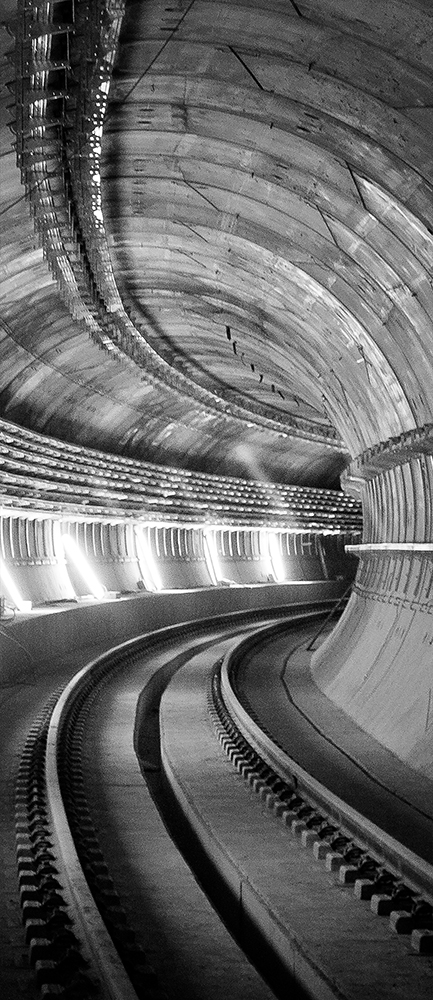
Metro
stołeczna sieć kolei podziemnej, budowana od 1983 r.
Historia warszawskiego metra jest długa i kręta – chyba nawet bardziej, niż wydrążone do tej pory pod ziemią tunele kolejowe. W chwili obecnej Warszawa dysponuje 2 liniami kolei podziemnej – pierwszą, oddaną do użytku w 1995 r. (chociaż ostatnią stację otworzono dopiero w 2008 r.) oraz drugą, wciąż budowaną (I etap inwestycji zakończono w 2015 r.). W sumie, na właściwą infrastrukturę warszawskiej kolei podziemnej składa się dziś 28 stacji, rozlokowanych na 30 kilometrach tras.
Mimo, że na budowę metra zdecydowano się w latach 80-tych, dzieje inwestycji sięgają okresu dwudziestolecia międzywojennego. Już w 1925 r. podjęto decyzję o budowie dwóch linii kolei podziemnej. 2 lata później Zarząd Miejski Warszawy powołał specjalistyczną komisję, która miała prowadzić nadzór nad pracami inżynieryjnymi. Niestety – globalny kryzys finansowy lat 30-tych pokrzyżował ambitne plany władz. Do idei budowy metra powrócono przed wojną raz jeszcze – w 1938 r., z inicjatywy ówczesnego prezydenta Warszawy Stefana Starzyńskiego. I tym razem, z oczywistych przyczyn, wszelkie plany musiały zostać wstrzymane.
Tuż po wojnie władze komunistyczne nawiązały do wizji prezydenta Starzyńskiego, znacznie jednak zmieniając jej zasadniczą koncepcję. Zdecydowano się na budowę metra głębokiego, które w kryzysowym momencie mogło pełnić rolę schronu przeciwatomowego (lata 50-te to okres tzw. zimnej wojny między USA a Związkiem Radzieckim, kiedy to stale nakręcano spiralę strachu, informując o zagrożeniu atakiem jądrowym z Zachodu). W ramach inwestycji rozpoczęto nawet wykopy w dzielnicy Targówek (wydrążono ok. 750 m szybów; zachowały się one do dziś). Prace nagle przerwano, z uwagi na problemy geologiczne. Oficjalnemu komunikatowi władz nikt jednak nie dawał wiary. Wszyscy wiedzieli, że prawdziwą przyczyną fiaska inwestycji jest kiepska sytuacja ekonomiczna kraju.
Chociaż lata 80-te również nie naznaczyły się w historii Polski jako okres szczególnej gospodarczej prosperity, decyzję o rozpoczęciu inwestycji w kolej podziemną jednak podjęto. Pierwsze postanowienia w tej sprawie zapadły już w połowie lat 70-tych. Gwałtowny przyrost naturalny mieszkańców Warszawy i powiększające się rzesze ludności napływowej sprawiały, że tradycyjna komunikacja miejska (tramwaje i autobusy) nie była w stanie sprawnie obsługiwać ponad miliona osób. Inicjacja budowy miała też aspekt propagandowy – rozpoczęto ją bowiem w tym samym czasie, kiedy zniesiono w Polsce stan wojenny. Chciano więc po części ukoić buntownicze nastroje społeczeństwa.
Pierwsza linia metra – budowana od 15 kwietnia 1983 r. do 25 października 2008 r. – jest usytuowana w kierunku północ-południe, wzdłuż lewobrzeżnej Warszawy. Ciągnie się od dzielnicy Bielany, przez Śródmieście, w kierunku Ursynowa. Odcinki ursynowskie i śródmiejskie oddano do połowy lat 90-tych. Na Bielany metro zajechało w pełnej okazałości dopiero w XXI w.
Tuż po finalizacji I linii kolei podziemnej, Urząd m.st. Warszawy – już w zupełnie innych okolicznościach politycznych – podjął decyzję o rozpoczęciu prac na budowie II linii metra. Linia M2 ma docelowo rozciągać się od skrajnych dzielnic zachodnich (Bemowo, Wola), przez centrum, w kierunku praskim. Centralny odcinek II linii zrealizowano w przeciągu 6 lat (2010-2015). Składa się on z 7 stacji, rozlokowanych na trasie o długości 6,1 km – od Woli, do Pragi Północ (M2 jest tym samym pierwszą linią, która przekroczyła Wisłę). Obecnie trwają przetargi na budowę kolejnych, skrajnych odcinków. Szacowany termin oddania całości II linii metra przypada na 2022 r.
Czy wiesz, że… ?
- Przez lata w Warszawie funkcjonowała miejska legenda, według której Józef Stalin chciał wręczyć ówczesnemu prezydentowi Polski Bolesławowi Bierutowi oraz ludowi stolicy dar od Związku Radzieckiego. Do wyboru było metro, bądź też wzniesiony później Pałac Kultury i Nauki.
- W planach Urzędu m.st. Warszawy jest również wybudowanie III linii metra. Według wstępnych planów, miałaby się ona zaczynać przy Dworcu Zachodnim w dzielnicy Ochota, dochodząc na drugą stronę Wisły aż w okolice dzielnicy Białołęka.
- Od początku działania, warszawskie metro jest obsługiwane przez wagony produkcji rosyjskiej serii 81. Posiadają one charakterystyczne wzory w poziome pasy, przypominające barwami flagę Rosji. Dla wielu warszawiaków był to powód do żartów. Stał się on jeszcze większy, gdy w 2000 r. na podziemnych trasach zadebiutował nowy tabor – Alstom Metropolis, przywodzący na myśl barwy niemieckie. Od 2013 r. warszawskie metro korzysta również z nowoczesnych wagonów Siemiens Inspiro.
- Budowę I linii warszawskiego metra realizowano tzw. metodą odkrywkową, tworząc wykopy w ziemi. Wyjątek stanowił odcinek śródmiejski. Aby nie paraliżować ruchu w centrum Warszawy, zdecydowano o zaprzężeniu do robót specjalnych walców drążeniowych sprowadzonych z ZSRR. Wytyczały one tunele metodą na kreta, pozostając stale ukrytymi pod ziemią.
- W 2014 r. żoliborska stacja Plac Wilsona została wyróżniona w prestiżowym konkursie amerykańskiej stacji telewizyjnej CNN, będąc uznaną za jedną z 12 najbardziej imponujących stacji metra w Europie.






